Early Pregnancy Regulates Expression of IkappaB Family in Ovine Spleen and Lymph Nodes
Abstract
1. Introduction
2. Results
2.1. Expression of BCL-3, NFKBIA, NFKBIB, NFKBIE, IKBKG, NFKBID and NFKBIZ mRNA in the Spleen and Lymph Nodes
2.2. Expression of IκB Proteins in the Spleen and Lymph Nodes
2.3. Immunohistochemistry for IκBβ and IKKγ Proteins in the Spleen and Lymph Nodes
3. Discussion
4. Materials and Methods
4.1. Animal Tissue Collection
4.2. RNA Extraction and qRT-PCR Assay
4.3. Western Blot
4.4. Immunohistochemistry Analysis
4.5. Statistical Analysis
5. Conclusions
Author Contributions
Funding
Institutional Review Board Statement
Informed Consent Statement
Data Availability Statement
Conflicts of Interest
References
- Deshmukh, H.; Way, S.S. Immunological basis for recurrent fetal loss and pregnancy complications. Annu. Rev. Pathol. 2019, 14, 185–210. [Google Scholar] [CrossRef] [PubMed]
- Abu-Raya, B.; Michalski, C.; Sadarangani, M.; Lavoie, P.M. Maternal immunological adaptation during normal pregnancy. Front. Immunol. 2020, 11, 575197. [Google Scholar] [CrossRef] [PubMed]
- Rocha, C.C.; da Silveira, J.C.; Forde, N.; Binelli, M.; Pugliesi, G. Conceptus-modulated innate immune function during early pregnancy in ruminants: A review. Anim. Reprod. 2021, 18, e20200048. [Google Scholar] [CrossRef] [PubMed]
- Quirke, L.D.; Maclean, P.H.; Haack, N.A.; Edwards, S.J.; Heiser, A.; Juengel, J.L. Characterization of local and peripheral immune system in pregnant and nonpregnant ewes. J. Anim. Sci. 2021, 99, skab208. [Google Scholar] [CrossRef]
- Gómez-Chávez, F.; Correa, D.; Navarrete-Meneses, P.; Cancino-Diaz, J.C.; Cancino-Diaz, M.E.; Rodríguez-Martínez, S. NF-κB and its regulators during pregnancy. Front. Immunol. 2021, 12, 679106. [Google Scholar] [CrossRef]
- Fang, S.; Zhang, T.; Qiao, H.; Hao, S.; Zhang, L.; Yang, L. Expression of nuclear factor kappa B components in the ovine maternal liver in early pregnancy periods. Anim. Sci. J. 2022, 93, e13724. [Google Scholar] [CrossRef]
- Hao, S.; Fang, H.; Fang, S.; Zhang, T.; Zhang, L.; Yang, L. Changes in nuclear factor kappa B components expression in the ovine spleen during early pregnancy. J. Anim. Feed Sci. 2022, 31, 3–11. [Google Scholar] [CrossRef]
- Yang, L.; Cai, C.; Fang, S.; Hao, S.; Zhang, T.; Zhang, L. Changes in expression of nuclear factor kappa B subunits in the ovine thymus during early pregnancy. Sci. Rep. 2022, 12, 17683. [Google Scholar] [CrossRef]
- Zhang, L.; Zhang, T.; Yang, Z.; Cai, C.; Hao, S.; Yang, L. Expression of nuclear factor kappa B in ovine maternal inguinal lymph nodes during early pregnancy. BMC Vet. Res. 2022, 18, 266. [Google Scholar] [CrossRef]
- Yamauchi, S.; Ito, H.; Miyajima, A. IkappaBeta, a nuclear IkappaB protein, positively regulates the NF-kappaB-mediated expression of proinflammatory cytokines. Proc. Natl. Acad. Sci. USA 2010, 107, 11924–11929. [Google Scholar] [CrossRef]
- Palmer, S.; Chen, Y.H. Bcl-3, a multifaceted modulator of NF-kappaB-mediated gene transcription. Immunol. Res. 2008, 42, 210–218. [Google Scholar] [CrossRef] [PubMed]
- MaruYama, T. The nuclear IκB family of proteins controls gene regulation and immune homeostasis. Int. Immunopharmacol. 2015, 28, 836–840. [Google Scholar] [CrossRef] [PubMed]
- Jeon, S.; Liu, Q.F.; Cai, H.; Jeong, H.J.; Kim, S.H.; Kim, D.I.; Lee, J.H. Administration of a herbal formulation enhanced blastocyst implantation via IκB activation in mouse endometrium. Chin. Med. 2020, 15, 112. [Google Scholar] [CrossRef] [PubMed]
- Toda, A.; Sawada, K.; Fujikawa, T.; Wakabayashi, A.; Nakamura, K.; Sawada, I.; Yoshimura, A.; Nakatsuka, E.; Kinose, Y.; Hashimoto, K.; et al. Targeting inhibitor of κB kinase β prevents inflammation-induced preterm delivery by inhibiting IL-6 production from amniotic cells. Am. J. Pathol. 2016, 186, 616–629. [Google Scholar] [CrossRef] [PubMed]
- Whalley, K. Brain-spleen link tunes immunity. Nat. Rev. Neurosci. 2020, 21, 350–351. [Google Scholar] [CrossRef]
- Marchetti, C.; Swartzwelter, B.; Gamboni, F.; Neff, C.P.; Richter, K.; Azam, T.; Carta, S.; Tengesdal, I.; Nemkov, T.; D’Alessandro, A.; et al. OLT1177, a β-sulfonyl nitrile compound, safe in humans, inhibits the NLRP3 inflammasome and reverses the metabolic cost of inflammation. Proc. Natl. Acad. Sci. USA 2018, 115, E1530–E1539. [Google Scholar] [CrossRef] [PubMed]
- Slawek, A.; Maj, T.; Chelmonska-Soyta, A. CD40, CD80, and CD86 costimulatory molecules are differentially expressed on murine splenic antigen-presenting cells during the pre-implantation period of pregnancy, and they modulate regulatory T-cell abundance, peripheral cytokine response, and pregnancy outcome. Am. J. Reprod. Immunol. 2013, 70, 116–126. [Google Scholar]
- Jalkanen, S.; Salmi, M. Lymphatic endothelial cells of the lymph node. Nat. Rev. Immunol. 2020, 20, 566–578. [Google Scholar] [CrossRef]
- Kapovic, M.; Rukavina, D. Kinetics of lymphoproliferative responses of lymphocytes harvested from the uterine draining lymph nodes during pregnancy in rats. J. Reprod. Immunol. 1991, 20, 93–101. [Google Scholar] [CrossRef]
- Klossner, R.; Groessl, M.; Schumacher, N.; Fux, M.; Escher, G.; Verouti, S.; Jamin, H.; Vogt, B.; Mohaupt, M.G.; Gennari-Moser, C. Steroid hormone bioavailability is controlled by the lymphatic system. Sci. Rep. 2021, 11, 9666. [Google Scholar] [CrossRef]
- Yang, L.; Liu, Y.; Lv, W.; Wang, P.; Wang, B.; Xue, J.; Zhang, L. Expression of interferon-stimulated gene 15-kDa protein, cyclooxygenase (COX) 1, COX-2, aldo-keto reductase family 1, member B1, and prostaglandin E synthase in the spleen during early pregnancy in sheep. Anim. Sci. J. 2018, 89, 1540–1548. [Google Scholar] [CrossRef] [PubMed]
- Li, N.; Zhao, Z.; Bai, J.; Liu, B.; Mi, H.; Zhang, L.; Li, G.; Yang, L. Characterization of the Th cytokines profile in ovine spleen during early pregnancy. J. Appl. Anim. Res. 2019, 47, 386–393. [Google Scholar] [CrossRef]
- Wang, Y.; Han, X.; Zhang, L.; Cao, N.; Cao, L.; Yang, L. Early pregnancy induces expression of STAT1, OAS1 and CXCL10 in ovine spleen. Animals 2019, 9, 882. [Google Scholar] [CrossRef]
- Bai, J.; Zhang, L.; Zhao, Z.; Li, N.; Wang, B.; Yang, L. Expression of melatonin receptors and CD4 in the ovine thymus, lymph node, spleen and liver during early pregnancy. Immunology 2020, 160, 52–63. [Google Scholar] [CrossRef]
- Cao, N.; Cao, L.; Gao, M.; Wang, H.; Zhang, L.; Yang, L. Changes in mRNA and protein levels of gonadotropin releasing hormone and receptor in ovine thymus, lymph node, spleen, and liver during early pregnancy. Domest. Anim. Endocrinol. 2021, 76, 106607. [Google Scholar] [CrossRef]
- Yang, L.; Guo, R.; Yao, X.; Yan, J.; Bai, Y.; Zhang, L. Expression of progesterone receptor and progesterone-induced blocking factor in the spleen during early pregnancy in ewes. Livest. Sci. 2018, 209, 14–19. [Google Scholar] [CrossRef]
- Zhang, L.; Yang, G.; Zhang, Q.; Feng, P.; Gao, M.; Yang, L. Early pregnancy affects expression of Toll-like receptor signaling members in ovine spleen. Anim. Reprod. 2021, 18, e20210009. [Google Scholar] [CrossRef] [PubMed]
- Yang, L.; Zang, S.; Bai, Y.; Yao, X.; Zhang, L. Effect of early pregnancy on the expression of progesterone receptor and progesterone-induced blocking factor in ovine lymph node. Theriogenology 2017, 93, 78–83. [Google Scholar] [CrossRef]
- Yang, L.; Wang, Q.; Liu, Y.; Zhang, L.; Lv, W.; Liu, B. Expression profiles of interferon-stimulated gene 15 and prostaglandin synthases in the ovine lymph nodes during early pregnancy. Mol. Reprod. Dev. 2019, 86, 100–108. [Google Scholar] [CrossRef]
- Yang, L.; Wang, P.; Mi, H.; Lv, W.; Liu, B.; Du, J.; Zhang, L. Comparison of Th1 and Th2 cytokines production in ovine lymph nodes during early pregnancy. Theriogenology 2019, 123, 177–184. [Google Scholar] [CrossRef]
- Zhang, L.; Cao, L.; Yang, F.; Han, X.; Wang, Y.; Cao, N.; Yang, L. Relative abundance of interferon-stimulated genes STAT1, OAS1, CXCL10 and MX1 in ovine lymph nodes during early pregnancy. Anim. Reprod. Sci. 2020, 214, 106285. [Google Scholar] [CrossRef]
- Feng, P.; Wu, J.; Ren, Y.; Zhang, L.; Cao, J.; Yang, L. Early pregnancy regulates the expression of prolactin and its receptor in the thymus, the liver, the spleen and lymph nodes in sheep. Domest. Anim. Endocrinol. 2022, 81, 106731. [Google Scholar] [CrossRef] [PubMed]
- Wu, J.; Zhang, Q.; Zhang, L.; Feng, P.; Gao, M.; Zhao, Z.; Yang, L. Toll-like receptor signaling is changed in ovine lymph node during early pregnancy. Anim. Sci. J. 2021, 92, e13541. [Google Scholar] [CrossRef] [PubMed]
- Zhang, L.; Cao, L.; Feng, P.; Han, X.; Yang, L. Complement regulation in ovine lymph nodes during early pregnancy. Exp. Ther. Med. 2022, 23, 166. [Google Scholar] [CrossRef] [PubMed]
- Zhao, Z.; Li, Y.; Cao, J.; Fang, H.; Zhang, L.; Yang, L. Early pregnancy modulates expression of the nod-like receptor family in lymph nodes of ewes. Animals 2022, 12, 3285. [Google Scholar] [CrossRef] [PubMed]
- Hövelmeyer, N.; Wörns, M.A.; Reissig, S.; Adams-Quack, P.; Leclaire, J.; Hahn, M.; Wörtge, S.; Nikolaev, A.; Galle, P.R.; Waisman, A. Overexpression of Bcl-3 inhibits the development of marginal zone B cells. Eur. J. Immunol. 2014, 44, 545–552. [Google Scholar] [CrossRef]
- Zhang, X.; Paun, A.; Claudio, E.; Wang, H.; Siebenlist, U. The tumor promoter and NF-κB modulator Bcl-3 regulates splenic B cell development. J. Immunol. 2013, 191, 5984–5992. [Google Scholar] [CrossRef]
- Tassi, I.; Claudio, E.; Wang, H.; Tang, W.; Ha, H.L.; Saret, S.; Ramaswamy, M.; Siegel, R.; Siebenlist, U. The NF-κB regulator Bcl-3 governs dendritic cell antigen presentation functions in adaptive immunity. J. Immunol. 2014, 193, 4303–4311. [Google Scholar] [CrossRef]
- Heikkilä, A.; Tuomisto, T.; Häkkinen, S.K.; Keski-Nisula, L.; Heinonen, S.; Ylä-Herttuala, S. Tumor suppressor and growth regulatory genes are overexpressed in severe early-onset preeclampsia—An array study on case-specific human preeclamptic placental tissue. Acta Obstet. Gynecol. Scand. 2005, 84, 679–689. [Google Scholar]
- Ong, S.T.; Hackbarth, M.L.; Degenstein, L.C.; Baunoch, D.A.; Anastasi, J.; McKeithan, T.W. Lymphadenopathy, splenomegaly, and altered immunoglobulin production in BCL3 transgenic mice. Oncogene 1998, 16, 2333–2343. [Google Scholar] [CrossRef]
- Scharfe-Nugent, A.; Corr, S.C.; Carpenter, S.B.; Keogh, L.; Doyle, B.; Martin, C.; Fitzgerald, K.A.; Daly, S.; O’Leary, J.J.; O’Neill, L.A. TLR9 provokes inflammation in response to fetal DNA: Mechanism for fetal loss in preterm birth and preeclampsia. J. Immunol. 2012, 188, 5706–5712. [Google Scholar] [CrossRef] [PubMed]
- Wuerzberger-Davis, S.M.; Chen, Y.; Yang, D.T.; Kearns, J.D.; Bates, P.W.; Lynch, C.; Ladell, N.C.; Yu, M.; Podd, A.; Zeng, H.; et al. Nuclear export of the NF-κB inhibitor IκBα is required for proper B cell and secondary lymphoid tissue formation. Immunity 2011, 34, 188–200. [Google Scholar] [CrossRef] [PubMed]
- McCracken, S.A.; Drury, C.L.; Lee, H.S.; Morris, J.M. Pregnancy is associated with suppression of the nuclear factor kappaB/IkappaB activation pathway in peripheral blood mononuclear cells. J. Reprod. Immunol. 2003, 58, 27–47. [Google Scholar] [CrossRef]
- Crinelli, R.; Bianchi, M.; Gentilini, L.; Magnani, M.; Hiscott, J. Activation of the ubiquitin proteolytic system in murine acquired immunodeficiency syndrome affects IkappaBalpha turnover. Eur. J. Biochem. 1999, 263, 202–211. [Google Scholar] [CrossRef] [PubMed]
- Lin, A.E.; Ebert, G.; Ow, Y.; Preston, S.P.; Toe, J.G.; Cooney, J.P.; Scott, H.W.; Sasaki, M.; Saibil, S.D.; Dissanayake, D.; et al. ARIH2 is essential for embryogenesis, and its hematopoietic deficiency causes lethal activation of the immune system. Nat. Immunol. 2013, 14, 27–33. [Google Scholar] [CrossRef] [PubMed]
- Tanaka, K.; Nakabayashi, K.; Kawai, T.; Tanigaki, S.; Matsumoto, K.; Hata, K.; Kobayashi, Y. Gene expression and DNA methylation changes in BeWo cells dependent on tumor necrosis factor-α and insulin-like growth factor-I. Hum. Cell 2020, 33, 37–46. [Google Scholar]
- Alves, B.N.; Tsui, R.; Almaden, J.; Shokhirev, M.N.; Davis-Turak, J.; Fujimoto, J.; Birnbaum, H.; Ponomarenko, J.; Hoffmann, A. IκBε is a key regulator of B cell expansion by providing negative feedback on cRel and RelA in a stimulus-specific manner. J. Immunol. 2014, 192, 3121–3132. [Google Scholar] [CrossRef] [PubMed]
- Clark, J.M.; Aleksiyadis, K.; Martin, A.; McNamee, K.; Tharmalingam, T.; Williams, R.O.; Mémet, S.; Cope, A.P. Inhibitor of kappa B epsilon (IκBε) is a non-redundant regulator of c-Rel-dependent gene expression in murine T and B cells. PLoS ONE 2011, 6, e24504. [Google Scholar] [CrossRef]
- Mémet, S.; Laouini, D.; Epinat, J.C.; Whiteside, S.T.; Goudeau, B.; Philpott, D.; Kayal, S.; Sansonetti, P.J.; Berche, P.; Kanellopoulos, J.; et al. IkappaBepsilon-deficient mice: Reduction of one T cell precursor subspecies and enhanced Ig isotype switching and cytokine synthesis. J. Immunol. 1999, 163, 5994–6005. [Google Scholar] [CrossRef]
- Clark, K.; Nanda, S.; Cohen, P. Molecular control of the NEMO family of ubiquitin-binding proteins. Nat. Rev. Mol. Cell Biol. 2013, 14, 673–685. [Google Scholar] [CrossRef]
- Sakowicz, A.; Hejduk, P.; Pietrucha, T.; Nowakowska, M.; Płuciennik, E.; Pospiech, K.; Gach, A.; Rybak-Krzyszkowska, M.; Sakowicz, B.; Kaminski, M.; et al. Finding NEMO in preeclampsia. Am. J. Obstet. Gynecol. 2016, 214, 538.e1–538.e7. [Google Scholar] [CrossRef] [PubMed]
- Siggs, O.M.; Berger, M.; Krebs, P.; Arnold, C.N.; Eidenschenk, C.; Huber, C.; Pirie, E.; Smart, N.G.; Khovananth, K.; Xia, Y.; et al. A mutation of Ikbkg causes immune deficiency without impairing degradation of IkappaB alpha. Proc. Natl. Acad. Sci. USA 2010, 107, 3046–3051. [Google Scholar] [CrossRef]
- Guo, L.; Huang, J.; Chen, M.; Piotrowski, E.; Song, N.; Zahner, G.; Paust, H.J.; Alawi, M.; Geffers, R.; Thaiss, F. T-lymphocyte-specific knockout of IKK-2 or NEMO induces Th17 cells in an experimental nephrotoxic nephritis mouse model. FASEB J. 2019, 33, 2359–2371. [Google Scholar] [CrossRef]
- Shiina, T.; Morimatsu, M.; Kitamura, H.; Ito, T.; Kidou, S.; Matsubara, K.; Matsuda, Y.; Saito, M.; Syuto, B. Genomic organization, chromosomal localization, and promoter analysis of the mouse Mail gene. Immunogenetics 2001, 53, 649–655. [Google Scholar] [CrossRef] [PubMed]
- Majumder, S.; Amatya, N.; Revu, S.; Jawale, C.V.; Wu, D.; Rittenhouse, N.; Menk, A.; Kupul, S.; Du, F.; Raphael, I.; et al. IL-17 metabolically reprograms activated fibroblastic reticular cells for proliferation and survival. Nat. Immunol. 2019, 20, 534–545. [Google Scholar] [CrossRef]
- Ishikawa, C.; Senba, M.; Mori, N. Induction of IκB-ζ by Epstein-Barr virus latent membrane protein-1 and CD30. Int. J. Oncol. 2015, 47, 2197–2207. [Google Scholar] [CrossRef]
- Sierra-Mondragón, E.; Gómez-Chávez, F.; Murrieta-Coxca, M.; Vázquez-Sánchez, E.A.; Martínez-Torres, I.; Cancino-Díaz, M.E.; Rojas-Espinosa, O.; Cancino-Díaz, J.C.; Reyes-Sánchez, J.L.; Rodríguez-Muñóz, R.; et al. Low expression of IL-6 and TNF-α correlates with the presence of the nuclear regulators of NF-κB, IκBNS and BCL-3, in the uterus of mice. Mol. Immunol. 2015, 68, 333–340. [Google Scholar] [CrossRef] [PubMed]
- Gómez-Chávez, F.; López-Portales, Ó.H.; Baeza-Martínez, D.A.; Cancino-Díaz, J.C.; Murrieta-Coxca, J.M.; Cancino-Díaz, M.E.; Pérez-Tapia, S.M.; Rodríguez-Martínez, S. IκBNS and IL-6 expression is differentially established in the uterus of pregnant healthy and infected mice. Heliyon 2020, 6, e04122. [Google Scholar] [CrossRef] [PubMed]
- Raghupathy, R.; Makhseed, M.; Azizieh, F.; Omu, A.; Gupta, M.; Farhat, R. Cytokine production by maternal lymphocytes during normal human pregnancy and in unexplained recurrent spontaneous abortion. Hum. Reprod. 2000, 15, 713–718. [Google Scholar] [CrossRef]
- Khoenkhoen, S.; Ádori, M.; Solís-Sayago, D.; Soulier, J.; Russell, J.; Beutler, B.; Pedersen, G.K.; Karlsson Hedestam, G.B. IκBNS expression in B cells is dispensable for IgG responses to T cell-dependent antigens. Front. Immunol. 2022, 13, 1000755. [Google Scholar] [CrossRef] [PubMed]
- Rajsbaum, R.; Versteeg, G.A.; Schmid, S.; Maestre, A.M.; Belicha-Villanueva, A.; Martínez-Romero, C.; Patel, J.R.; Morrison, J.; Pisanelli, G.; Miorin, L.; et al. Unanchored K48-linked polyubiquitin synthesized by the E3-ubiquitin ligase TRIM6 stimulates the interferon-IKKε kinase-mediated antiviral response. Immunity 2014, 40, 880–895. [Google Scholar] [CrossRef] [PubMed]
- McKay, L.I.; Cidlowski, J.A. Cross-talk between nuclear factor-kappa B and the steroid hormone receptors: Mechanisms of mutual antagonism. Mol. Endocrinol. 1998, 12, 45–56. [Google Scholar] [CrossRef] [PubMed]
- Livak, K.J.; Schmittgen, T.D. Analysis of relative gene expression data using real-time quantitative PCR and the 2(-Delta Delta C(T)) method. Methods 2001, 25, 402–408. [Google Scholar] [CrossRef] [PubMed]

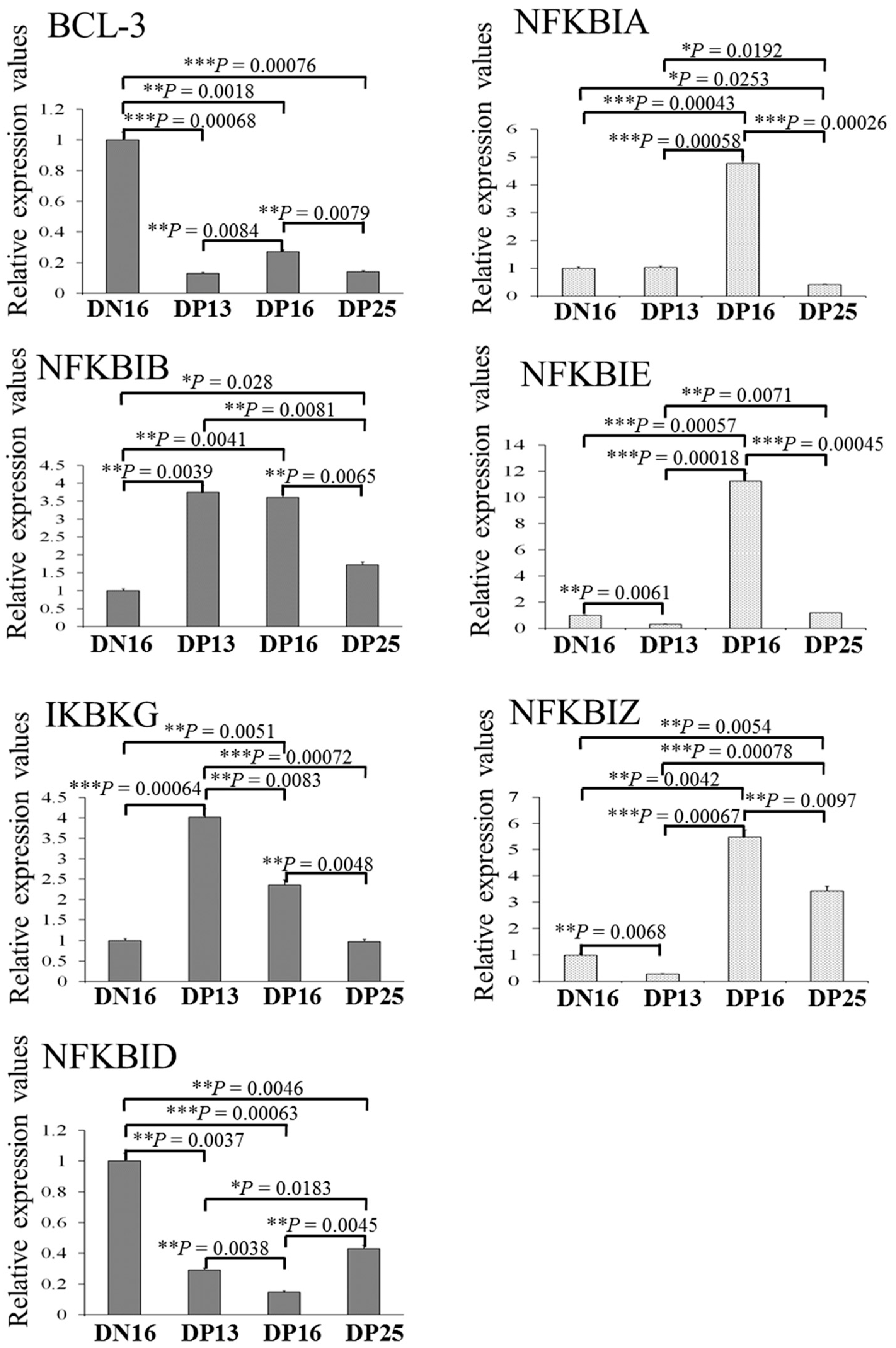
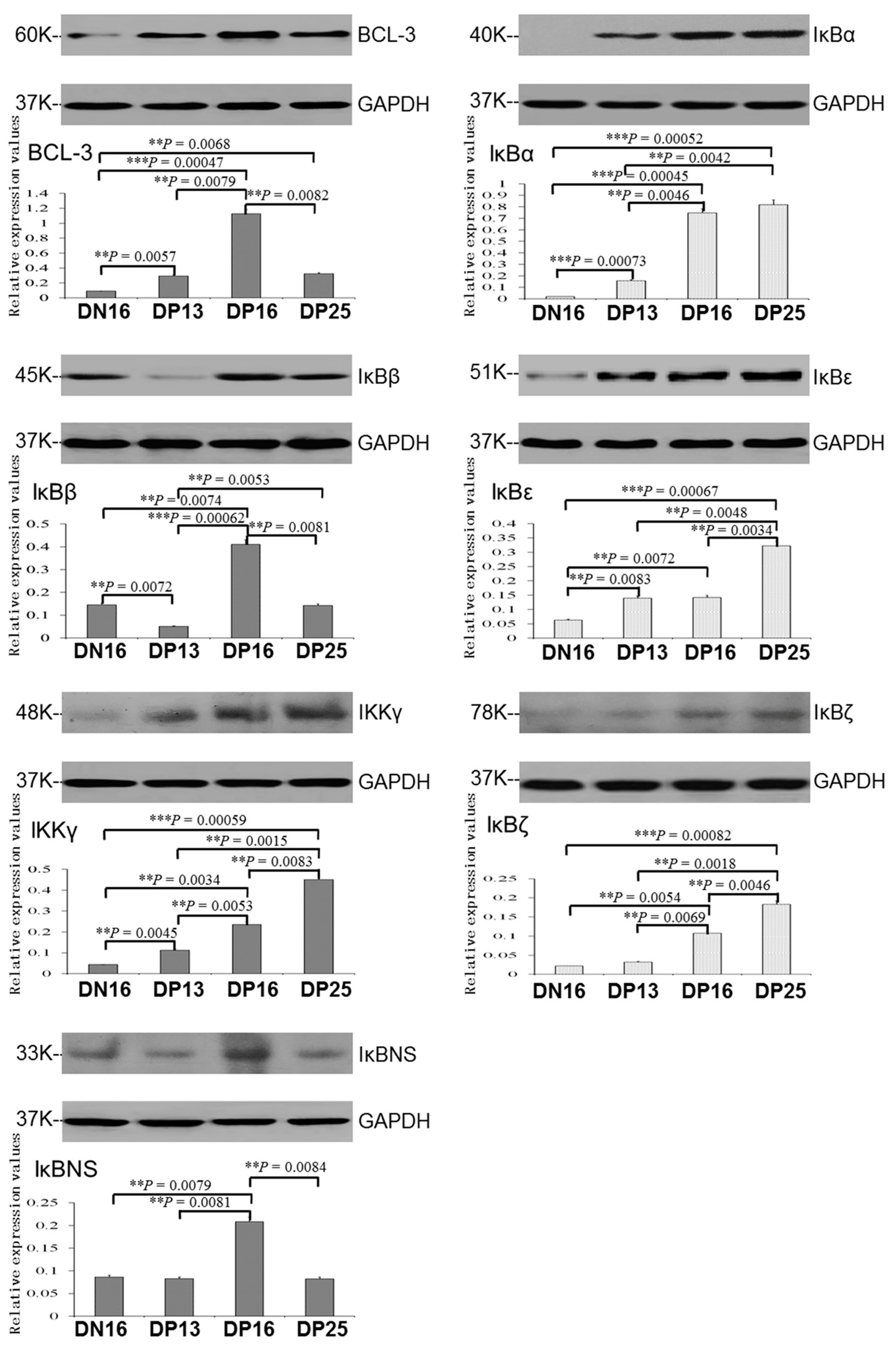
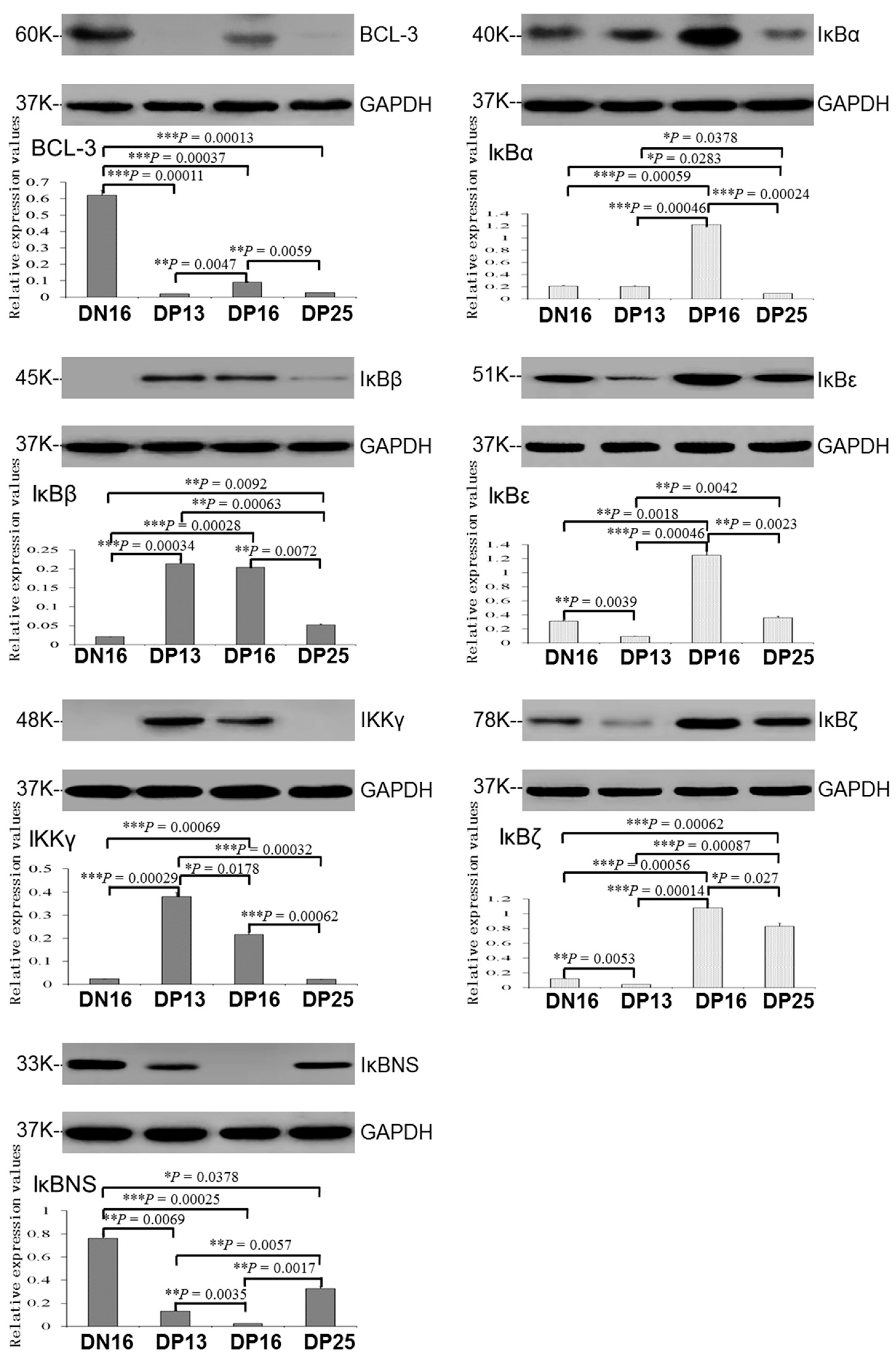
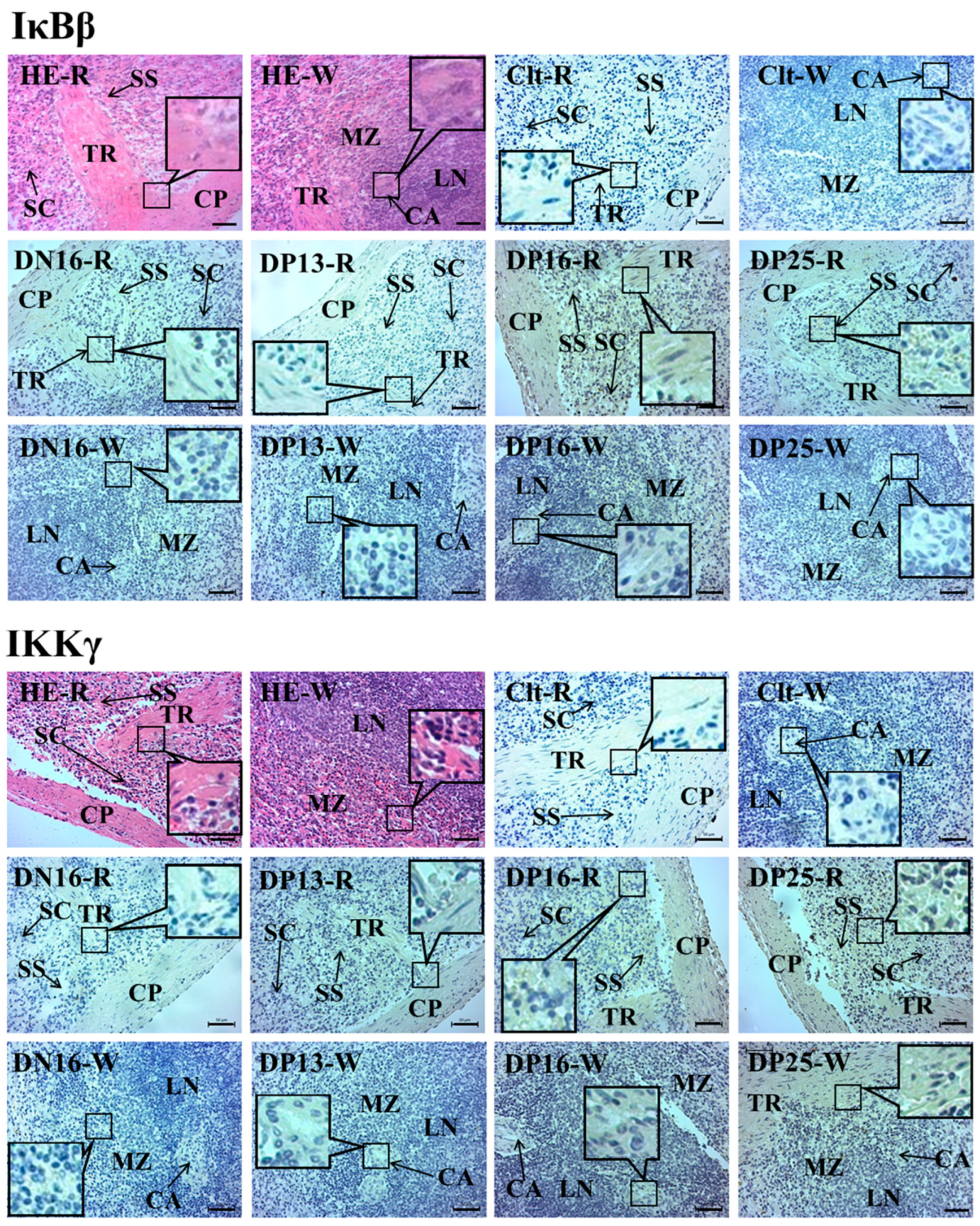
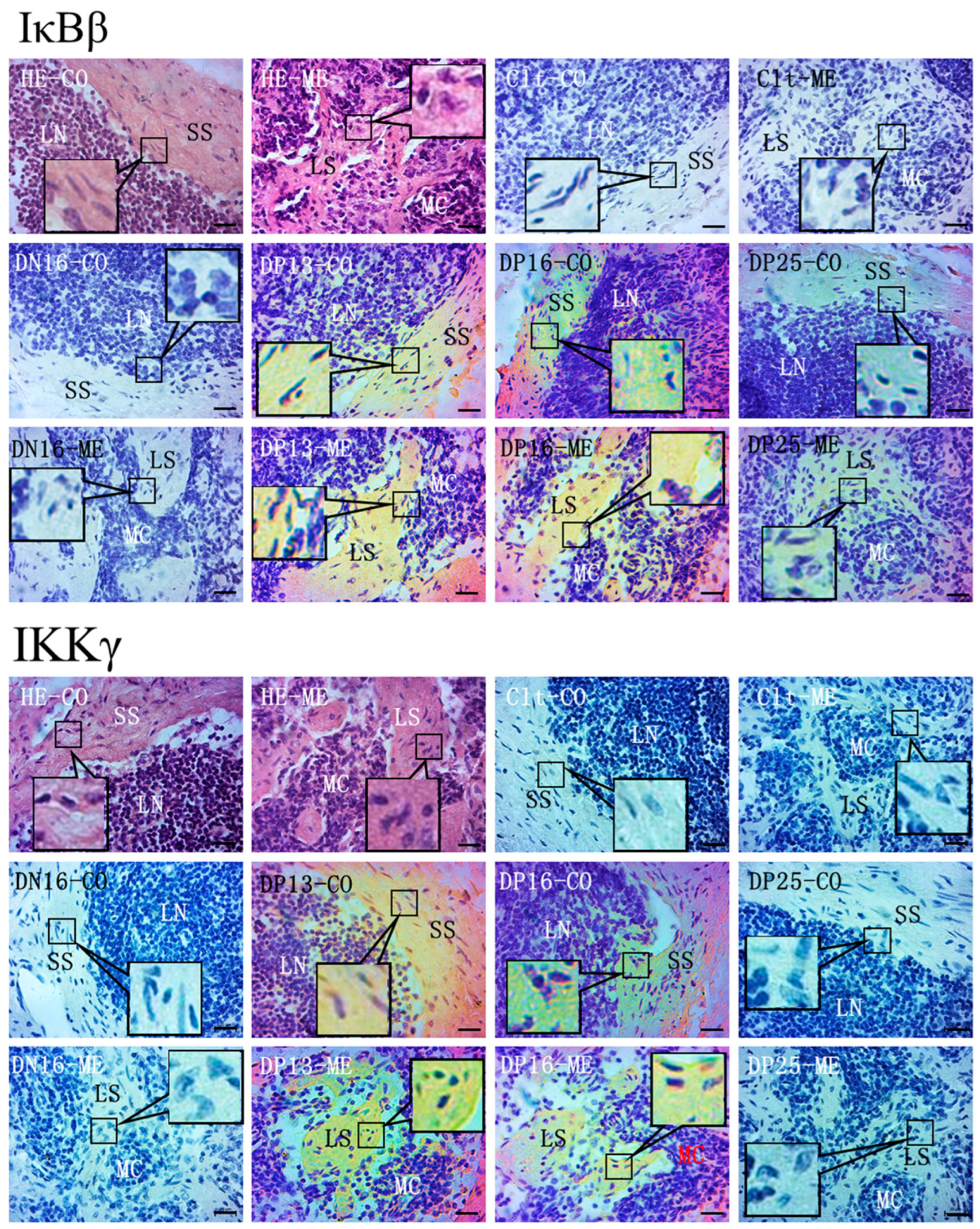
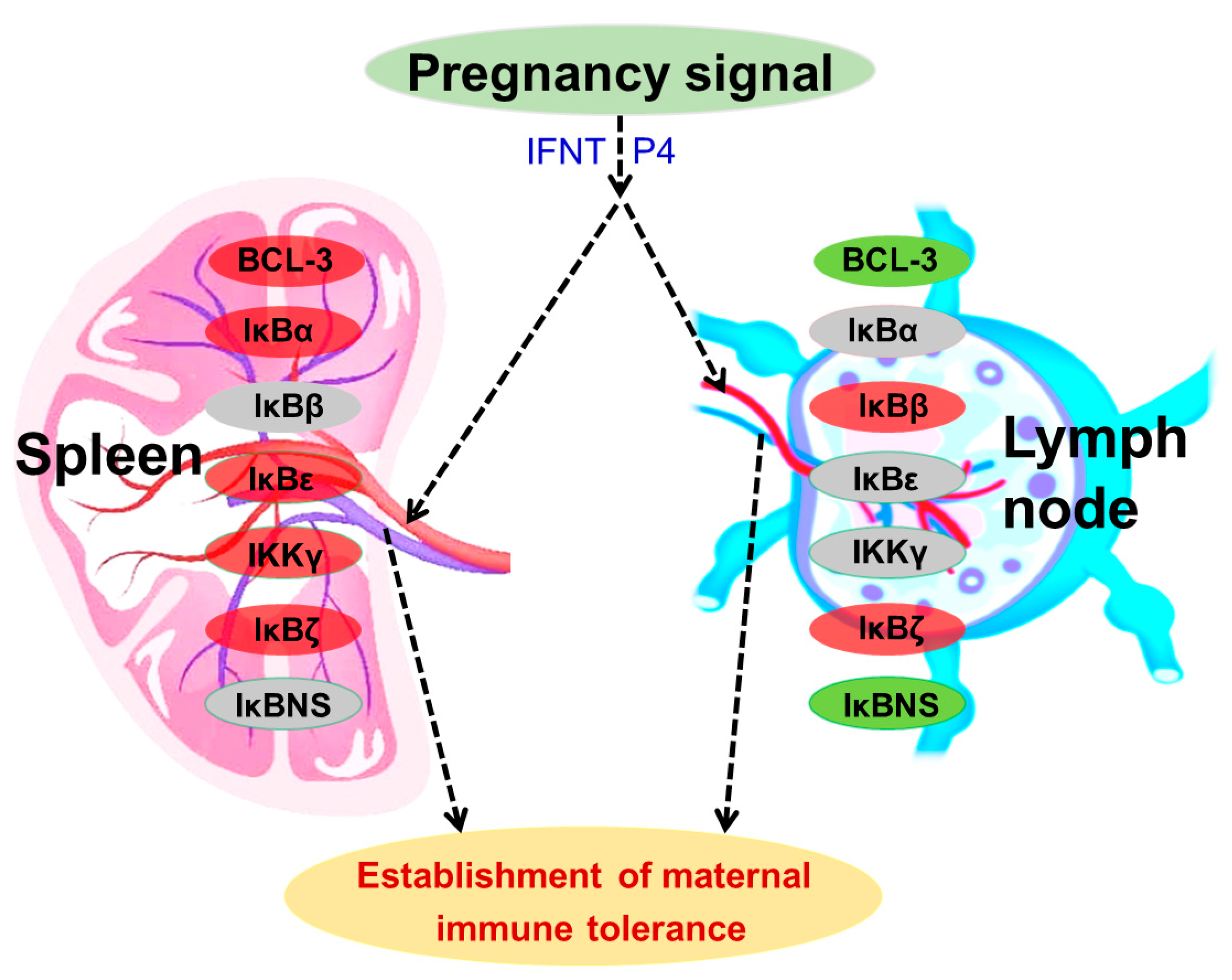
| Gene | Primer | Sequence | Size (bp) | Accession Numbers |
|---|---|---|---|---|
| BCL-3 | Forward | GCGACCAGAGGCAATTTACTACCAG | 98 | XM_027978453.2 |
| Reverse | GAGGTGTAGGCAAGTTCAGCAGAG | |||
| NFKBIA | Forward | AGGACGAGGAGTATGAGCAGATGG | 130 | NM_001166184.1 |
| Reverse | GCCAAGTGCAGGAACGAGTCTC | |||
| NFKBIB | Forward | CCCCAAGACCTACCTCGCTCAG | 119 | XM_027978262.2 |
| Reverse | TCCAGTCCTCTTCACTCTCATCCTC | |||
| NFKBIE | Forward | GCACTCACGTACATTTCCGAGGAC | 97 | XM_042236979.1 |
| Reverse | GCAGCAGAGCCAGGCAATACAG | |||
| IKBKG | Forward | GGGCAACCAGAGGGAGGAGAAG | 146 | XM_027963334.2 |
| Reverse | GGCATGTCTTCAGGCGTTCCAC | |||
| NFKBIZ | Forward | GCAAAGGCGTACAATGGAAACACC | 137 | NM_001306117.1 |
| Reverse | GGCTGCTCGTTCTCCAAGTTCC | |||
| NFKBID | Forward | ACATTCGTGAGCATAAGGGCAAGAC | 114 | XM_027977435.2 |
| Reverse | GATGGTCAGTGGCATTGGGTTCC | |||
| GAPDH | Forward | GGGTCATCATCTCTGCACCT | 176 | NM_001190390.1 |
| Reverse | GGTCATAAGTCCCTCCACGA |
Disclaimer/Publisher’s Note: The statements, opinions and data contained in all publications are solely those of the individual author(s) and contributor(s) and not of MDPI and/or the editor(s). MDPI and/or the editor(s) disclaim responsibility for any injury to people or property resulting from any ideas, methods, instructions or products referred to in the content. |
© 2023 by the authors. Licensee MDPI, Basel, Switzerland. This article is an open access article distributed under the terms and conditions of the Creative Commons Attribution (CC BY) license (https://creativecommons.org/licenses/by/4.0/).
Share and Cite
Fang, S.; Cai, C.; Bai, Y.; Zhang, L.; Yang, L. Early Pregnancy Regulates Expression of IkappaB Family in Ovine Spleen and Lymph Nodes. Int. J. Mol. Sci. 2023, 24, 5156. https://doi.org/10.3390/ijms24065156
Fang S, Cai C, Bai Y, Zhang L, Yang L. Early Pregnancy Regulates Expression of IkappaB Family in Ovine Spleen and Lymph Nodes. International Journal of Molecular Sciences. 2023; 24(6):5156. https://doi.org/10.3390/ijms24065156
Chicago/Turabian StyleFang, Shengya, Chunjiang Cai, Ying Bai, Leying Zhang, and Ling Yang. 2023. "Early Pregnancy Regulates Expression of IkappaB Family in Ovine Spleen and Lymph Nodes" International Journal of Molecular Sciences 24, no. 6: 5156. https://doi.org/10.3390/ijms24065156
APA StyleFang, S., Cai, C., Bai, Y., Zhang, L., & Yang, L. (2023). Early Pregnancy Regulates Expression of IkappaB Family in Ovine Spleen and Lymph Nodes. International Journal of Molecular Sciences, 24(6), 5156. https://doi.org/10.3390/ijms24065156





